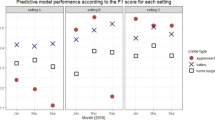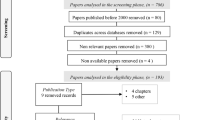Abstract
The main objective of this study is to test and compare the prediction performance of three of the most common predictive policing methods. A near-repeat model, a supervised machine learning model, and a risk terrain model are tested and compared against each other using retrospective analysis of home burglary crime data from a Belgian city. Hotspot analysis is included as a baseline. Predictions are made for three different months (January, May and September 2017) to account for seasonal differences. Variations in spatial context (city center vs. suburbs) and the number of predicted risk locations are also tested. Prediction performance is measured using accuracy, near-hit rate, precision and F1-score. The results show that there are some notable differences in prediction performance between the model types across the tested variations. In general, the ensemble model tends to be the most consistent high performer across all tested variations. Also notable is that hotspot analysis is not clearly outperformed by the other methods. The different methods have their own strengths and weaknesses and optimal prediction performance crucially depends on the specific location context. More comparative analyses of predictive policing methods in different contexts are needed to gain a more complete picture. Future research could also focus on how combining methods can help improve crime prediction performance.




Similar content being viewed by others
Notes
Home burglary is defined as follows: “theft from a home by breaking and entering or illegally trespassing, including attempts”. Additionally, we use a ‘pure’ definition, in the sense that we only included burglaries in the residence proper and not into annexes such as garages; as the latter type of burglaries tends to have different characteristics and patterns.
In this study the latter approach is used.
References
Andresen, A., & Hodgkinson, T. (2018). Predicting property crime risk: An application of risk terrain modeling in Vancouver, Canada. European Journal on Criminal Policy and Research (online first), 24, 373–392. https://doi.org/10.1007/s10610-018-9386-1.
Arnesson, A. & Lewenhage, K. (2018). Comparison and prediction of temporal hotspot maps. Master thesis, Faculty of Computing at Blekinge Institute of Technology, Sweden.
Bogomolov, A., Lepri, B., Staiano, J., Oliver, N., Pianesi, F., Pentland, A. (2014). Once upon a crime: Towards crime prediction from demographics and mobile data. In: ICMI ‘14 Proceedings of the 16th International Conference on Multimodal Interaction, 427–434.
Bowers, K. J., & Johnson, S. D. (2005). Domestic burglary repeats and space-time clusters: The dimensions of risk. European Journal of Criminology, 2(1), 67–92.
Bowers, K. J., Johnson, D. S., & Pease, K. (2004). Prospective hot-spotting: The future of crime mapping? British Journal of Criminology, 44, 641–658.
Chainey, S., Tompson, L., & Uhlig, S. (2008). The utility of hotspot mapping for predicting spatial patterns of crime. Security Journal, 21, 4–28.
Chan, J., & Moses, L. B. (2015). Is big data challenging criminology? Theoretical Criminology, 20(1), 21–39.
Daley, D., Bachmann, W., Bachmann, B. A., Pedigo, C., Bui, M. T., & Coffman, J. (2016). Risk terrain modeling predicts child maltreatment. Child Abuse & Neglect, 62, 29–38.
Dugato, M. (2013). Assessing the validity of risk terrain modeling in a European city: Preventing robberies in the city of Milan. Crime Mappin, 5(1), 63–89.
ESRI (n.d.) Repeat and near-repeat analysis. ArcGIS solutions for local government. Available online at: http://solutions.arcgis.com/local-government/help/repeat-and-near-repeat-analysis/ (Retrieved 06/08/2018).
Haykin, S. (2009). Neural networks and learning machines (3rd ed.). New York: Pearson.
Heffner, J. (2013). The statistics of risk terrain modeling. Online at: https://www.azavea.com/blog/2013/07/17/statistics-risk-terrain-modeling/ (Retrieved 02/08/2018).
Hunt, P., Saunders, J. & Hollywood, J.S. (2014). Evaluation of the Shreveport predictive policing experiment. RAND Safety and Justice Program.
Johnson, S. D., & Bowers, K. J. (2004). The burglary as clue to the future: The beginnings of prospective hot-spotting. European Journal of Criminology, 1(2), 237–255.
Johnson, S.D., Bowers, K., Birks, D. & Pease, K. (2009). Predictive mapping of crime by ProMap: Recall, units of analysis and the environmental backcloth. In: Weisburd, D., Bernasco, W. & Bruinsma G.J.N. (eds.) Putting crime in its place: Units of analysis in spatial crime research, 171-189.
Kennedy, L., & Caplan, J. (2010). Risk terrain modeling manual: Theoretical framework and technical steps of spatial risk assessment for crime analysis. Newark: Rutgers.
Kennedy, L. W., Caplan, J. M., & Piza, E. (2011). Risk clusters, hotspots, and spatial intelligence: Risk terrain modeling as an algorithm for police resource allocation strategies. Journal of Quantitative Criminology, 27(3), 339–362. https://doi.org/10.1007/s10940-010-9126-2.
Manning, C., Raghavan, P., & Schütze, H. (2008). Evaluation in information retrieval. In: Introduction to Information Retrieval, 139–161. Cambridge: Cambridge University Press.
Mohler, G. O., Short, M. B., Brantingham, P. H., Schoenberg, F. P., & Tita, G. E. (2011). Self-exciting point process modeling of crime. Journal of the American Statistical Association, 106(493), 100–108.
Mohler, G., Carter, J., & Raje, R. (2018). Improving social harm indices with a modulated Hawkes process. International Journal of Forecasting, 34(3), 431–439.
Moreto, W.D. & Caplan, J.M. (2010). Forecasting global maritime piracy utilizing the risk terrain modeling ((RTM) approach. Rutgers center on public security brief.
Moreto, W. D., Piza, E. L., & Caplan, J. M. (2014). “A plague on both your houses?”: Risks repeats and reconsiderations of urban residential burglary. Justice Quarterly, 31(6), 1102–1126.
Moses, L. B., & Chan, J. (2016). Algorithmic prediction in policing: Assumptions, evaluation and accountability. Policing and Society. https://doi.org/10.1080/10439463.2016.1253695.
Ohyama, T., & Amemiya, M. (2018). Applying crime prediction techniques to Japan: A comparison between risk terrain modeling and other methods. European Journal on Criminal Policy and Research, 24, 469–487. https://doi.org/10.1007/s10610-018-9378-1.
Ratcliffe, J. (2014). What is the future of… predictive policing? Translational Criminology, 6, 4–5.
Ratcliffe, J. (2016). Intelligence-led policing (2nd ed.). Abingdon: Routledge.
Ratcliffe, J., & Rengert, G. F. (2008). Near-repeat patterns in Philadelphia shootings. Security Journal, 21, 58–76.
Reinhart, A., & Greenhouse, J. (2018). Self-exciting point processes with spatial covariates: Modelling the dynamics of crime. Applied Statistics, Series C, 67(5), 1305–1329.
Rumi, S. K., Deng, K., & Salim, F. D. (2018). Crime event prediction with dynamic features. EPJ Data Science, 7(43), 1–27. https://doi.org/10.1140/epjds/s13688-018-0171-7.
Rummens, A., Hardyns, W., & Pauwels, L. (2017a). The use of predictive analysis in spatiotemporal crime forecasting: Building and testing a model in an urban context. Applied Geography, 86, 255–261. https://doi.org/10.1016/j.apgeog.2017.06.011.
Rummens, A., Hardyns, W., & Pauwels, L. (2017b). A scoping review of predictive analysis techniques for predicting criminal events. In G. Vermeulen & E. Lievens (Eds.), Data protection and privacy under pressure: Transatlantic tensions, EU surveillance and big data. Maklu: Antwerp ISBN 978-90-466-0910-1.
Sammut, C., & Webb, G. (Eds.). (2010). Encyclopedia of machine learning. Boston: Springer.
Saunders, J., Hunt, P., & Hollywood, J. S. (2016). Predictions put into practice: A quasi-experimental evaluation of Chicago’s predictive policing pilot. Journal of Experimental Criminology, 12(3), 347–371.
Short, M. B., D'Orsogna, M. R., Brantingham, P. J., & Tita, G. E. (2009). Measuring and modeling repeat and near-repeat burglary effects. Journal of Quantitative Criminology, 25(3), 325–339.
Street, A. E., Rosellini, A. J., Ursano, R. J., Heeringa, S. G., Hill, E. D., Monahan, J., Naifeh, J. A., Petukhova, M. V., Reis, B. Y., Sampson, N. A., Bliese, P. D., Stein, M. B., Zaslavsky, A. M., & Kessler, R. C. (2016). Developing a risk model to target high-risk preventive interventions for sexual assault victimization among female U.S. Army soldiers. Clinical Psychological Science, 4(6), 939–956.
Tibshirani, R., Witten, D., & Hastie, T. (2013). An introduction to statistical learning with applications in R. New York: Springer.
Townsley, M., Homel, R., & Chaseling, J. (2003). Infectious burglaries: A test of the near-repeat hypothesis. British Journal of Criminology, 43, 615–633.
Wang, X., & Brown, D. E. (2012). The spatio-temporal modeling for criminal incidents. Security Informatics, 1(2), 1–17.
Wang, B., Penghang, Y., Bertozzi, A. L., Brantingham, P. J., Osher, S. J., & Xin, J. (2019). Deep learning for real time crime forecasting and its Ternarization. Chinese Annals of Mathematics, Series B, 40(6), 949–966.
Weisburd, D., Bruinsma, G. J. N., & Bernasco, W. (2009). Putting crime in its place: Units of analysis in spatial crime research. New York: Springer-Verlag.
Zhou, Z.-H. (2012). Ensemble methods: Foundations and algorithms. Machine learning and pattern recognition series. Abingdon: CRC Press.
Author information
Authors and Affiliations
Corresponding author
Ethics declarations
Conflict of Interest
The authors declare no conflicts of interest.
Additional information
Publisher’s Note
Springer Nature remains neutral with regard to jurisdictional claims in published maps and institutional affiliations.
Rights and permissions
About this article
Cite this article
Rummens, A., Hardyns, W. Comparison of near-Repeat, Machine Learning and Risk Terrain Modeling for Making Spatiotemporal Predictions of Crime. Appl. Spatial Analysis 13, 1035–1053 (2020). https://doi.org/10.1007/s12061-020-09339-2
Received:
Accepted:
Published:
Issue Date:
DOI: https://doi.org/10.1007/s12061-020-09339-2




